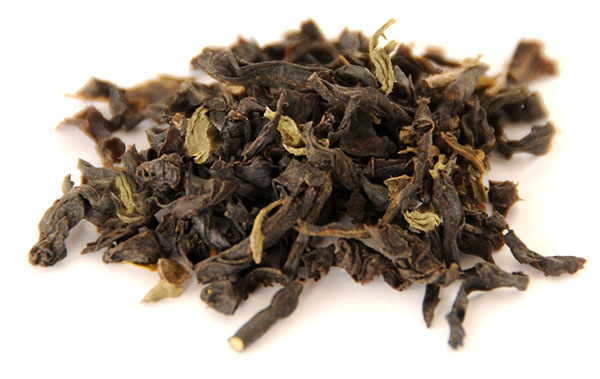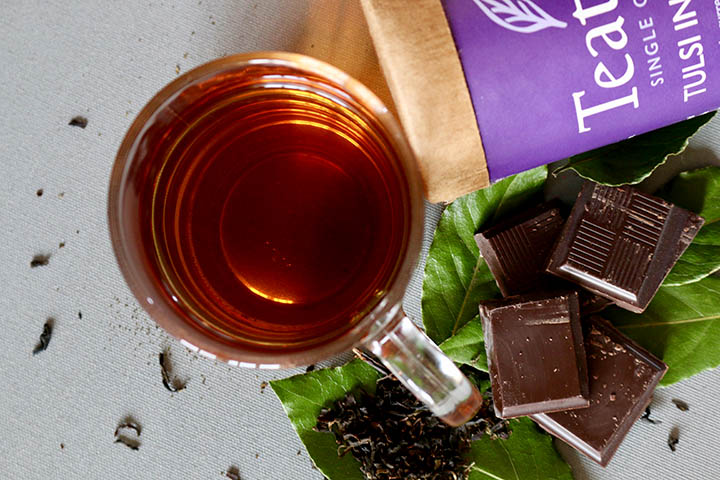So exactly how did this revered herb end up in our teacups?

How It Grows
Tulsi (Ocimum tenuiflorum or Ocimum sanctum) is commonly known as holy basil. “Holy” because of its history of religious and spiritual significance, and “basil” because it comes from the same perennial herb and shrub family as the common cooking basil. Tulsi is part of the Lamiaceae family of aromatic flowering herbs that also contains mint, sage, oregano, rosemary, and lavender.
Tulsi is native to the Indian subcontinent and flourishes in humid, tropical climates. It is widely grown and cultivated throughout the Southeast Asian tropics. It grows as an erect branched shrub that reaches up to 60cm tall and boasts furry stems, fragrant purple or green leaves, and small white to purplish flowers that shoot out the tip of the branches. Its leaves are cultivated, picked, and dried for use in herbal tea applications.
There are three major varieties of the tulsi plant, each with different characteristics:
-
Krishna:
Known as purple leaf tulsi for its most marked characteristic of purple leaves and blossoms, this plant has the spicy aroma of cloves and its leaves mimic the sharp, crisp flavors of pepper. It’s widely grown across India and is often found decorating private homes and gardens. -
Rama:
Boasting green leaves and white or light purple flowers, this green leaf tulsi is known for its clove-like aroma. It has a more cooling and mellow flavor than purple leaf tulsi. It’s grown across India but can also be found in China, Nepal, Bengal, and Brazil. -
Vana:
This wild leaf tulsi is indigenous to Asia and parts of Africa. It can be found growing wild as well as cultivated in the Himalayas and across the plains of India. The plant boasts light green leaves and has more of a refreshing citrus aroma and flavor than its spicy cousins.
Tulsi Legends
As a plant with religious and spiritual significance, tulsi has a rich history of legends to explain how it came to be and why it is worshipped.
One such legend marks the plant as the earthly manifestation of Lakshmi, the goddess of wealth and principle consort to the Hindu god Vishnu. Lakshmi was one of Vishnu’s three wives and perhaps his favorite. Jealousy ensues and the other two wives curse Lakshmi to be born on earth as a plant. The other two wives, Ganga and Saraswati, then curse each other to be born on earth as rivers (the Ganges River and the Saraswati River). Vishnu comforts Lakshmi that she will be born on earth as the tulsi plant, but only part of her will be rooted on earth as a plant and her spirit will return to be connected with him.
Another legend relates tulsi to the Samudra Manthana, the churning of the cosmic ocean by the gods and demons. At the end of the churning battle, Dhanvantari, the physician to the gods, rises victorious from the ocean with the elixir of immortality and offers it to the gods. The Hindu god Vishnu sheds happy tears for the gift, the first of which fell into the elixir and sprouted the tulsi plant.
Yet another legend regards the tulsi plant as a threshold point between heaven and earth. A traditional prayer tells that the creator-god Brahma resides in its branches, all Hindu pilgrimage centers reside in its roots, the Ganges River flows through its roots, all deities in its stem leaves, and the Hindu scriptures in the upper part of its branches.
How It’s Used
In Hindu worship: Tulsi is a sacred plant that Hindus regard as the earthly manifestation of Lakshmi, the goddess of wealth and principle consort of the Hindu god Vishnu. Worshipers of Vishnu wear beaded prayer necklaces made of tulsi stems, and water mixed with tulsi petals is given to the dying to raise their departing souls to heaven. Tulsi Vivah is the ceremonial marriage of the tulsi plant to the Hindu god Vishnu. The day of the ceremony varies from region to region and signifies the end of the monsoon season and the beginning of the Hindu wedding season. In addition to being worshiped at ceremonies and temples, the tulsi plant is worshipped at home. The plant can be found growing in many Hindu households, traditionally planted in a home’s central courtyard in earthen clay pots ornamented with images of deities or other religious figures. Some houses may keep up to a dozen or more tulsi plants to create a miniature holy basil forest.
In Ayurveda: The tulsi plant has been used for thousands of years in Ayurveda, a form of traditional Indian medicine. In Ayurveda, tulsi is considered an adaptogen, a natural herb that helps the body adapt to outside stressors. The herb is used in many forms—fresh, dried, powdered, herbal tea, essential oil—as an Ayurvedic remedy for a variety of common ailments.
In Thai cuisine: Holy basil leaves (or “kaphrao” in Thai) are commonly found as an ingredient in Thai cuisine. They are best known in a stir-fry dish made with holy basil, pork or seafood, and rice. Holy basil should not be confused with Thai basil, however, which is also a common ingredient in Thai cuisine. Both basils have different flavors profile they impart into a dish.
In the garden: A 1903 London horticulture report claimed that when the Royal Victoria Gardens were established in Bombay, “the men employed on those works were pestered by mosquitoes. At the recommendation of the Hindu managers, the whole boundary of the gardens was planted with holy basil, on which the plague of mosquitoes was at once abated, and fever altogether disappeared from among the resident gardeners." Holy basil is still planted in gardens today as a common insect repellant. The dried leaves may also be mixed with stored grains to repel insects.
As a tea: Like any other tea or herbal infusion, fresh or dried tulsi leaves can be steeped in hot water to produce a tea-like beverage. If steeped on its own, tulsi as an herbal infusion is completely caffeine free.
Tasting Tulsi

Tulsi is typically noted to have a strong aroma and an astringent, sometimes bitter flavor. Being related to the culinary basil family, it can have floral and peppery notes as well. Some types of tulsi may also have a clove-like aroma and spiced flavor, while others may yield a fresh, lemony aroma and flavor. Our Teatulia®’s Tulsi Infusion Tea is a blend of our Teatulia black tea leaves and tulsi leaves.

This invigorating black tea blend has a rich, full-bodied spiciness with just a subtle hint of sweetness. It brews into a deep red-colored liquor with the aroma of sweet, fresh flowers. It’s a uniquely flavored cup of tea with undercurrents of unsweetened cocoa and bubble gum in a hearty black tea base. It also makes an invigorating iced tea; it’s so good over ice, in fact, that we created an easy-to-brew Tulsi Infusion Iced Tea.
Preparing Tulsi
Here are a few general tips for brewing a great cup of Teatulia Tulsi Infusion Tea:
- Use fresh, pure, cold filtered water. Spring water is best.
- Because this is an herb and black tea blend, it is generally steeped in just boiled water at a temperature around 200 to 212 degrees. If you’re steeping just the tulsi leaves, you can use the same temperature for an herbal tea.
- If you don’t have an electric kettle with temperature control, just remember that at sea level water simmers at 190 degrees and boils at 212 degrees. The boiling temperature drops about a degree for every 1,000 feet in altitude increase.
- If your tulsi herb came with specific recommendations for brewing, use those. For our Teatulia Tulsi Infusion, we use one tea bag or up to one tablespoon of loose leaf tea per 8 oz. cup of water.
- Cover the Tulsi Infusion while it’s steeping to keep all the heat in the vessel.
- Taste the brewed tulsi after the recommended infusion time (we steep our Tulsi Infusion for 2 to 3 minutes) and then decide if you’d like it to go a little longer. Teatulia Tulsi Infusion can typically be infused a couple of times.
- Teatulia Tulsi Infusion is gorgeous to sip on its own. But like a traditional black tea, our blend of black tea and tulsi leaves can also be enjoyed with milk or cream and even a little sweetener.
Buying & Storing Tulsi
As a dried herb, tulsi won’t ever really go “bad” but it can get stale. Be sure and buy tulsi from a reputable company that can tell you when and how the herb was processed and packaged. Most herbs have the best flavor when brewed and enjoyed as soon as possible after their processing date. But if stored properly, it can stay fresh and drinkable for up to two years. To ensure your tulsi stays as fresh as possible as long as possible, take care to store it in a cool, dark place, away from light, oxygen, moisture and fragrant pantry companions like coffee or spices.
For more information about how to best care for your teas and herbs, visit our How to Store Tea page.
Sources:
Ocimum tenuiflorum via Wikipedia Tulsi Holy Basil via About Religion Tulsi in Hinduism via Wikipedia What is Tulsi? via About Food

